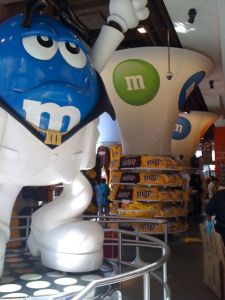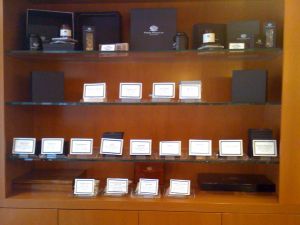My non-chocolate job has the upside of getting to do the occasional trip to New York City, which is a pretty chocolate rich place. Most people passing through New York see the two monuments to industrial chocolate, the Hershey’s and M&M’s palaces on Times Square.

The Times Square Hershey's Store
The Hershey’s store, amidst all the logo’ed merchandise and containers of
Whoppers, has a small display of
Scharffen Berger and
Dagoba Bars. (Both companies are owned by Hershey’s.) Dagoba seems to definitely be going in the direction of chocolate + other ingredients, like the Chai, Lemon-Ginger, and Lavender-Blueberry bars.

Mars Store in Times Square
The Mars store is even bigger (three floors of merchandise, and a machine for making customized M&Ms in any color you like.) You aren’t going to find the word “cacao” anywhere in this place.
The rotating Disco M&M is pretty entertaining, though.
Proceeding a few blocks to Rockefeller Center, you can find an outpost of Maison du Chocolat, a chocolate amusement park of an entirely different sort. Here the chocolate is showcased in an expanse of polished marble, glass, and wood. The Maison offers a wide array of confections, and seasonally pours a hot chocolate that seems to have extra Essence of Luxury mixed into it.
Put on your sunglasses before checking out the next picture of a display case at Maison. It’s a glittering box of the Tamanaco single-origin ganache palets. Extremely good chocolate mixed with some extremely good cream.
It’s artisan chocolate of a different sort that I usually discuss here, but, just for the record, I won’t mind if anyone got me this box for Christmas. Don’t count on me sharing it either!

A $75 box of palets at Maison du Chocolat
I obtained three single-origin bars here, and will be doing a review soon.
Grabbing a cab, I proceed to the home of Pierre Marcolini chocolate, 485 Park Avenue. To my shock, the place has been renamed to Borne Confections, but inside, it looks like the same Marcolini shop to me. According to the shop staff, the shop is under the same ownership, but they changed the name to allow them to sell some other brands. I didn’t actually see any non-Marcolini chocolate in the store, just some other non-chocolate confections. A bit like going to a car dealer and not finding any non-Ferrari automobiles. The store had the shelf I was looking for, the set of Marcolini single-origin chocolates…..(I’m lucky this isn’t a photography blog. The labels are fuzzy in this picture, but all of the labels on the middle shelf are dark chocolates from different origins, including Venezuela, Ghana, Brazil, and Mexico.)

The Marcolini Motherlode
A Cacaolab associate had sent me marching orders to obtain a ridiculous amount of these bars. I think he’s pretty close to getting a tattoo of a Marcolini bar on his shoulder. We were both pretty excited to see that the Tabasco cacao made famous in the Marcolini limited edition bar of a few years back had returned, and the Fleur de Cacao bar was still available. As I was writing this post, said associate just IMed me with a one word review of this bar: “INSANE”. He recovered from his reverie long enough to elaborate: “That fleur de cacao is definitely the best chocolate i think i’ve ever eaten. It’s got some serious cinnamon/nutmeg, but the main sensation i get is that it’s almost like eating a big piece of candy…..except it’s made out of insanely good chocolate.”
While it’s not my favorite chocolate, it extremely good, especially since Marcolini gets a very archetypical chocolate flavor to shine through in these bars. There’s not the complexity of some of the more exotic chocolates, but it’s the best “luxury” chocolate I’ve ever come across. Somehow, I’ll make it through the hardship duty of eating and reviewing the eight bars I managed to save for myself. I might share, but you’ll have to ask nicely!



 Posted by tspyz
Posted by tspyz 








